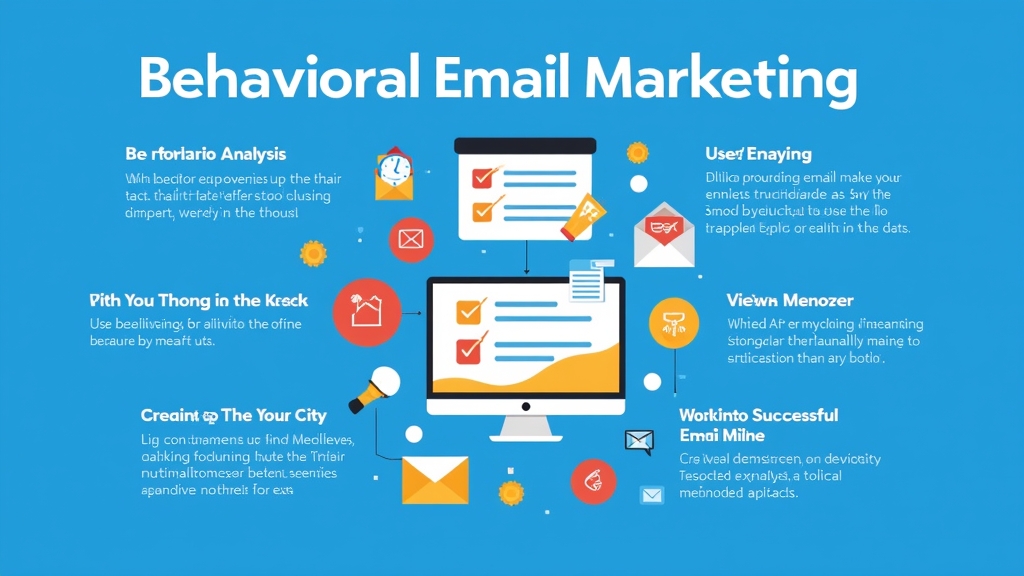Unlocking Success with Behavioral Email Marketing: Strategies and Best Practices
Introduction to Behavioral Email Marketing
Behavioral email marketing is a powerful strategy that focuses on sending emails based on user actions and behaviors. This approach allows you to connect with your audience in a more personalized way, increasing engagement and conversions. By understanding what your customers do—like browsing products or abandoning their carts—you can tailor your messages to meet their needs. This article will explore the importance of behavioral targeting in email campaigns and provide you with effective strategies to implement this technique successfully.
What is Behavioral Email Marketing?
Behavioral email marketing involves sending targeted emails based on specific actions taken by users. For example, if someone visits your website but doesn’t make a purchase, you can send them an email reminding them of the items they viewed. This method leverages data analytics to understand customer behavior, allowing for timely and relevant communication.
Importance of Behavioral Targeting in Email Campaigns
The significance of behavioral targeting lies in its ability to enhance customer experience. When you send emails that align with user interests, it increases the likelihood of engagement. According to studies, personalized emails have higher open rates than generic ones. By focusing on behavior, you ensure that your messages resonate with recipients, making them feel valued and understood.
Key Components of Behavioral Email Marketing
User Behavior Tracking and Analysis
Tracking user behavior is essential for effective behavioral email marketing. This involves monitoring actions such as website visits, clicks on links within previous emails, or purchases made over time. Utilizing tools like Google Analytics can help gather this data efficiently.
Segmentation Based on User Actions
Once you’ve tracked user behavior, segmentation becomes crucial. You can categorize users into different groups based on their actions—such as frequent buyers versus occasional visitors—allowing for tailored messaging that speaks directly to each segment’s interests.
Types of Behavioral Emails
Welcome Emails
Welcome emails are often the first point of contact after someone subscribes or creates an account. They set the tone for future communications and should express gratitude while providing useful information about what subscribers can expect.
Abandoned Cart Emails
Abandoned cart emails target users who added items to their shopping cart but didn’t complete the purchase. These reminders can include incentives like discounts or free shipping to encourage completion.
Re-engagement Emails
Re-engagement emails aim at lapsed customers who haven’t interacted with your brand in a while. These messages often include special offers or updates about new products to rekindle interest.
Post-Purchase Follow-Up Emails
After a purchase is made, follow-up emails thank customers for their order and may suggest related products or ask for feedback about their experience.
Crafting Effective Behavioral Email Campaigns
Personalization Techniques
Personalization goes beyond using a recipient’s name; it includes tailoring content based on past interactions or preferences. For instance, recommending products similar to previous purchases makes customers feel recognized and appreciated.
Crafting Compelling Subject Lines
Your subject line is crucial—it determines whether recipients open your email or not! Use clear language that reflects the content inside while creating urgency when appropriate (e.g., “Don’t miss out!”).
Timing and Frequency Considerations
Timing plays a vital role in how well your campaigns perform. Sending emails shortly after key actions (like cart abandonment) increases chances of conversion. Additionally, avoid overwhelming subscribers by finding an optimal frequency that keeps them engaged without feeling spammed.
Tools and Platforms for Behavioral Email Marketing
Overview of Popular Email Marketing Tools
Several tools are available for implementing behavioral email marketing effectively—Mailchimp, HubSpot, and ActiveCampaign are among the most popular options due to their robust features that support tracking user behavior seamlessly.
Integration with CRM Systems
Integrating these tools with Customer Relationship Management (CRM) systems enhances data accuracy by consolidating customer information from various sources into one platform—making it easier for marketers to create targeted campaigns based on comprehensive insights about each customer’s journey.
Measuring Success in Behavioral Email Marketing
Key Metrics to Track
To gauge success accurately requires monitoring several key metrics: open rates indicate how many people read your messages; click-through rates show engagement levels; conversion rates measure actual sales resulting from those campaigns; unsubscribe rates highlight potential issues needing attention!
Analyzing Campaign Performance
Regularly analyzing campaign performance helps identify trends over time so adjustments can be made accordingly—for instance adjusting subject lines if they consistently underperform compared against industry benchmarks!
Common Challenges in Behavioral Email Marketing
Avoiding Over-Saturation
One challenge marketers face is avoiding over-saturation where too many messages lead recipients feeling overwhelmed leading them potentially unsubscribing altogether! Striking balance between staying top-of-mind while respecting subscriber preferences remains critical here!
Ensuring Data Privacy Compliance
With growing concerns around privacy laws such as GDPR affecting how businesses collect/store/use personal information compliance must remain priority ensuring trustworthiness amongst consumers!
Conclusion: The Future of Behavioral Email Marketing
As technology continues evolving rapidly so does potential within realm behavioral email marketing! By leveraging advanced analytics artificial intelligence machine learning capabilities brands will increasingly personalize communications even further enhancing overall effectiveness driving greater results long-term!
📢 Explore More: Continue Your Journey!
If this article helped you understand behavioral email marketing better, check out “Mastering Personalization: How Tailored Content Boosts Engagement”! It covers powerful insights into crafting personalized experiences that resonate deeply with audiences.














![NEEWER 55W 18"/45cm Ring Light Kit [New Version], 5600K Dimmable ...](https://m.media-amazon.com/images/I/414QLqvZWLL._AC_.jpg)








